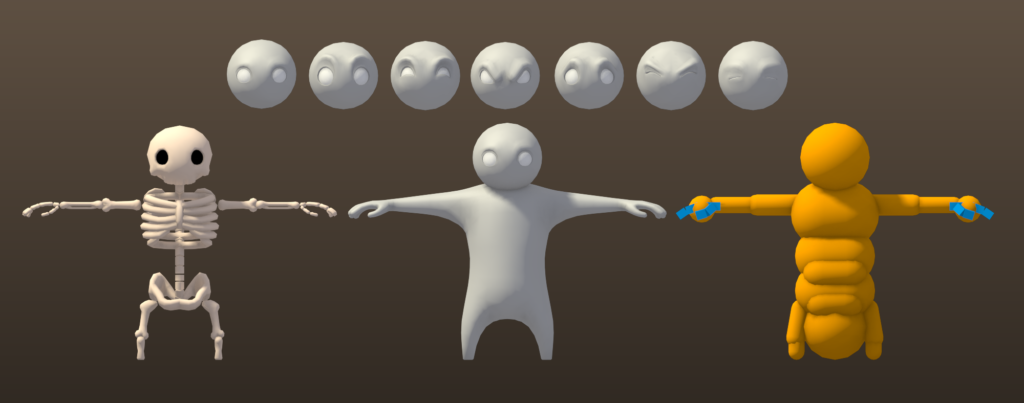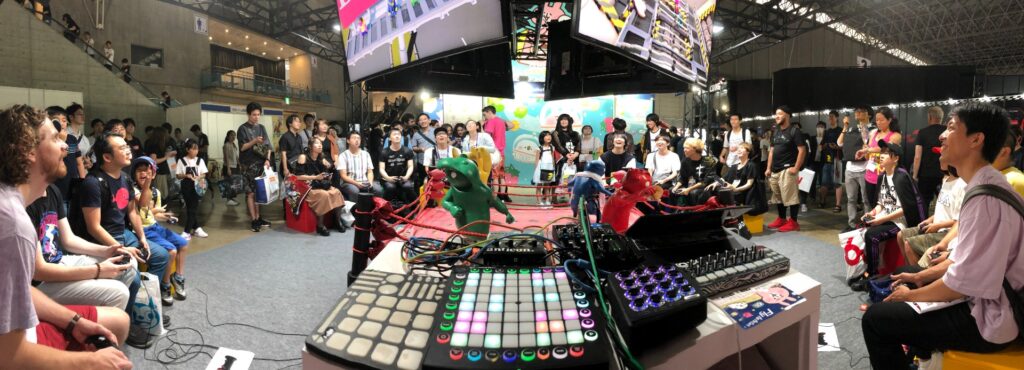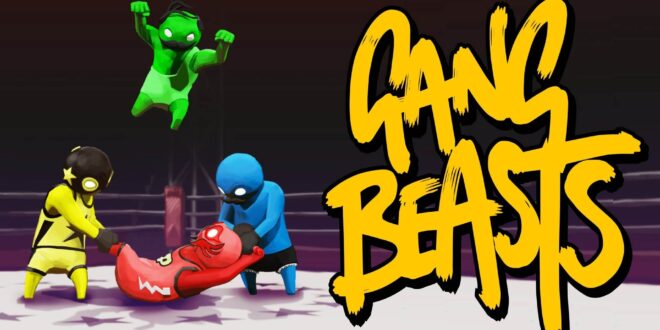
Easy to pick up gameplay that can be understood after watching just a few seconds of the game. A simplistic but iconic style that sets up a recognisable brand and distinguishes it from the competition. Plus instant popularity with some of the biggest YouTubers and Twitch streamers in the world?
Before Fall Guys, there was Gang Beasts.
Gang Beasts, in case you need reminding, is an anarchic beat ‘em up multiplayer title, developed (and now self-published) by UK studio Boneloaf. The game saw its official release in 2017, though it had been in early access on PC since August 2014. Before even that though, early prototypes of the game had attracted the attention of high-profile gaming influencers.
It’d be quite the accomplishment for any seasoned developer. Which makes it all the more impressive that Gang Beasts came from a team of three brothers, learning game development as they went along.
Boneloaf was founded in 2011 by brothers James, Jonathan and Michael Brown, to make experiences informed by their childhood. Michael Brown gives us the rundown on how the three brothers created the social media sensation.
LEARN ON THE JOB
“When we first started, we didn’t really know what we were doing,” says Brown. “I was studying game design, but I didn’t have a programming or 3D modelling background, or anything like that. My brothers: one was working at [UK games and tech retailer] CEX at the time, and the other was teaching Fine Art.”
So when the three got to work on game development, they tailored the games they made (including a few game jam projects) to cater to their lack of experience
“We originally started out making a different game, a high fantasy game, kind of like Golden Axe meets Shadow of the Colossus. But we found we didn’t have the skills to make that really work at the time, because literally, we were learning on the job. So we decided, if you can punch someone in the face, you’ve got a game. So we started to try and make a Final Fight/Street of Rage clone.”
With the game’s direction set, the team decided early on to include what became one of Gang Beasts’ most compelling elements: its physics-based gameplay.
“We figured, because we don’t have an animator, we can’t make smooth animations and stuff – so let’s try it with physics. We kept plugging away until it worked – we didn’t realise how much of a headache that would be, but it’s been an absolute nightmare.
“I mean, we’ve actually rebuilt the game three times now. The first version of the game was written in Javascript, but then we learned how to do C#, so we switched over to that. But then Unity updated their physics engine. The performance gains were so substantial, we needed to do it – but that also had the side effect of breaking all our physics. And so we had to rebuild again. Every time it’s gotten more efficient, cleaner, and we’re actually rebuilding the game again now. We’ve got Unity on board with us, and they’re helping us fix a lot of the legacy issues.”
The game’s physics is obviously central to the Gang Beasts experience: but it goes even deeper than that. In order to get the physics functioning in the way it needed to, it dictated even the game’s iconic character design.
“We messed around with the physics, and just slowly evolved the character from that,” says Brown. “There’s just so many different variations of physics characters that we’ve built. Part of the reason why the characters look the way that they do is because of these experiments, and the problems we kept running up against.
“They have short legs, because there’s an invisible ball between them, which helps them not only move around, but also helps with collision detection on the ground. They don’t have feet because the feet were getting caught on things. They are solid colours, because it was actually a placeholder art. We figured ‘oh, we’ll get time to do proper art later.’ But people liked it, so we kept it. They have solid white eyes because we needed a way of figuring out which way they were facing. No neck, because… we just couldn’t be bothered to do a neck.”
The game’s character design may have been born out of the realities of game development: But it certainly helped with the game’s enormous success. The simplistic design is easily recognisable, giving Gang Beasts an definitive brand. It’s this simplicity of design that likely helped it attract the attention of some of the biggest YouTubers and Twitch streamers, propelling the game to mainstream attention.

LIKE AND SUBSCRIBE
“It pretty much blew up,” says Brown. “We were at a game developer meetup that was part of my university, run by a friend. And me and James decided that we’d take the game down there, see what people thought of the prototype.
“People liked it, and played it all night. We thought that we probably wouldn’t get that much exposure again. So we uploaded the prototype to Indie DB. And within an hour or two of uploading it, it was played on a Giant Bomb livestream to I think 40,000 people, and then like a week or so later Dan NerdCubed said ‘greenlight this game!’ And yeah it got greenlit, and we’ve been playing catch up ever since.”
Such immediate, enormous attention is of course a dream scenario for game developers. But for a team learning as they went along, it must have come with a fair amount of pressure too.
“It was kind of terrifying, really!” says Brown. “I mean it was great. It was amazing. But like, we thought we’d kind of be on a long burner. That we’d be able to learn, take our time, not have a massive following. We thought we’d be able to take our time over it. And then there’s just loads of people!”
Over the years, the game has attracted an international audience. That’s certainly been boosted by its YouTuber and livestream-friendly gameplay, but it goes deeper than that. The easily understood gameplay and identifiable characters instantly transcends any language barrier – no matter who you are or where you live, you’ll understand Gang Beasts instantaneously.
“We’re lucky that we’ve been so successful,” says Brown, “but it’s not all about the success. At the end of the day, we’re not in it for the money. It’s about seeing the fans enjoying the game.
“It’s completely bizarre for me, I love it. We took the game to the Tokyo Game Show, and I didn’t think anybody would know what it was. But we had some people just running past with their arms in the air, cheering Gang Beasts. And just like, the places that we’ve seen the game turn up… it’s been in the White House, it’s been in the Playboy Mansion. It’s been played in the bottom of a pool…. It’s been everywhere. It’s mind blowing for me.”

FAMILY MATTERS
What stands out most about Boneloaf, at least to me, is that it’s a family business. While the studio has grown and hired more staff over the years to keep up with its success, the family atmosphere seems to inform everything they do.
It’s that family dynamic that informed Gang Beasts itself: a game you can play on the sofa together with your family, and beat the ever-living hell out of them.
Still, as anyone with siblings can tell you, working with your family can sound like a great idea in the abstract – but be an absolute nightmare in reality.
Or, as Brown puts it: “Well, it makes sense that a game made by a family would be about fighting!”
Still, Brown seems delighted to be able to work together with his family.
“Actually, we recently hired our sister too, she’s helping out with some of our admin work – and my wife does the marketing as well! It’s great, but at the same time, it is challenging.
“There’s certain things that just probably wouldn’t work in a different kind of company, a more formal company. But at the same time, family comes first, and that includes employees as well.”
For much of Gang Beasts’ life, it was published by Double Fine Presents. In May 2020, Boneloaf parted ways with their publisher, announcing their move to self-publishing in a post titled ‘Boneloaf take Double Fine to a fancy restaurant so they won’t make a big scene.’
Despite the split, Brown has nothing but positive things to say about Double Fine, thanking them for their help in the early days of Gang Beasts’ life.
“Part of the reason we went with Double Fine, is because when they first heard about the game, they played it and immediately gave us a bunch of feedback. Just straight off the bat. And with some of the other publishers we talked to, it seemed like a bit closed while this was just friendly.
“It was really amazing working with them, but with them being published by Microsoft now it didn’t make sense anymore. It made more sense to go our separate ways – though I can’t wait for quarantine to be over so we can go visit them again!”
So that’s that for the past of Gang Beasts then. But what of the future? As they move to self-publish the game, Boneloaf still has big plans for the game – looking to finally pay full homage to the games that inspired it all those years ago.
“There’s a lot of plans,” says Brown, “we have quite a large exhaustive list and we’re trying to tackle it all. So for example, we were originally trying to make a Final Fight/Streets of Rage game. So we want to add a campaign mode to Gang Beasts, where you go down the streets and fight gangs of people – hence the title, Gang Beasts.
“Another thing is escalations. Some stages escalate already: like the elevator stage will malfunction and then eventually fall. We want to add them to every single stage. There’s currently an arbitrary five minute timer that stops the level. We never liked that, but we needed it for technical reasons.
“So instead of having the timer, the idea is to have, say, the truck stage going along the road and have the escalation be having it veer off the road into a billboard. And then on the billboard stage have the same sort of thing, like a truck veers into it and just takes out the billboard. So we can kind of tie all the levels together.”
Brown also reveals that the team is looking into introducing a ranked mode to the game: so your anarchic grappling could soon be taken to a more competitive level.
Either way though, it seems Boneloaf has plans to keep you fighting your family for years to come.

 MCV/DEVELOP News, events, research and jobs from the games industry
MCV/DEVELOP News, events, research and jobs from the games industry




